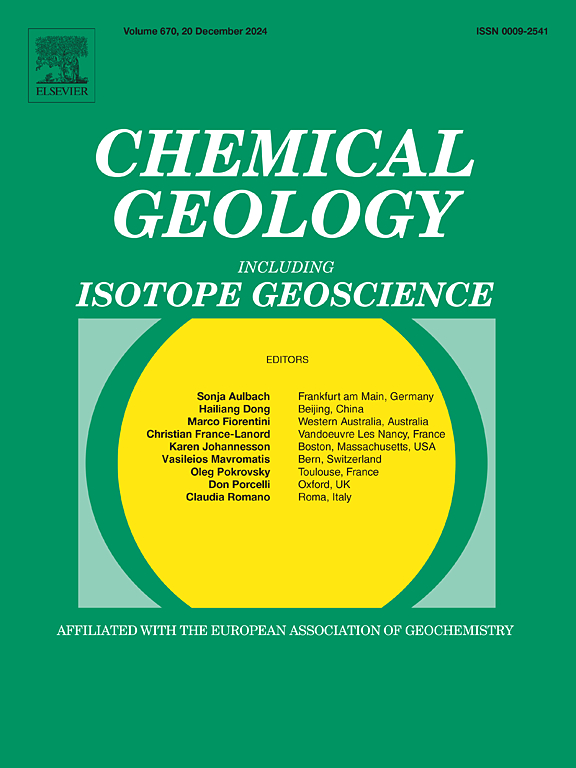Study of the sources and dispersion of sediments on the Sunda Shelf based on the investigation of rare earth element concentrations and Nd isotope compositions
IF 3.6
2区 地球科学
Q1 GEOCHEMISTRY & GEOPHYSICS
引用次数: 0
Abstract
The Sunda Shelf receives substantial sediment inputs from the Tibetan Plateau and Southeast Asia's mountainous islands, impacting southern South China Sea sedimentation during Quaternary sea-level changes. Due to multiple river basins contributing to the shelf, the origin and distribution of its surface sediments remain poorly defined. Here, we analyzed major and trace element concentrations and Nd isotope compositions (143Nd/144Nd expressed in epsilon units, εNd) of sediments from rivers around the Sunda Shelf and its surface sediments, focusing on <63 μm and < 2 μm fractions to evaluate grain size effects on rare earth element (REE) patterns and εNd compositions and to identify sediment sources. Significant differences in UCC-normalized REE patterns between <2 μm and < 63 μm river sediment fractions indicate a notable grain size effect. However, εNd variations between these fractions are typically less than 1 εNd unit, suggesting minimal grain size impact on Nd isotope compositions of the detrital fractions. Surface sediments on the western Sunda Shelf derive from the Malay Peninsula, Mekong River, and northern Thai rivers based on the δEuUCC-(Gd/Yb)UCC diagram. εNd spatial distribution of the detrital fraction indicates nearshore sediments of the Sunda Shelf are influenced by neighboring rivers (from −15.8 to −6.6), while the central region is affected by the Mekong and northern Thai rivers (from −15.8 to −10.3). Notably, unradiogenic εNd in central shelf sediments indicates Thai river sediments were transported there via paleo-channels during low sea levels before the Gulf of Thailand fully flooded. A large eddy in the central Sunda Shelf would have conserved these relic sediments and redistributed modern sediments by sorting and transporting sediments from nearby rivers.
基于稀土元素浓度和Nd同位素组成的巽他陆架沉积物来源与分散研究
巽他陆架接收了大量来自青藏高原和东南亚山地岛屿的沉积物输入,在第四纪海平面变化期间影响了南海南部的沉积。由于多个河流流域构成了陆架,陆架表面沉积物的来源和分布仍然不明确。本文分析了巽他陆架周边河流及其表层沉积物的主微量元素浓度和Nd同位素组成(143Nd/144Nd, εNd),重点分析了<;63 μm和<;2 μm馏分,评价粒度对稀土元素(REE)模式和εNd组成的影响,并确定沉积物来源。ucc归一化稀土模式在<;2 μm和<;63 μm河流沉积物组分具有明显的粒度效应。然而,这些碎屑组分之间的εNd差异通常小于1个εNd单位,表明粒径对碎屑组分Nd同位素组成的影响很小。根据δEuUCC-(Gd/Yb)UCC图,巽他陆架西部表层沉积物主要来自马来半岛、湄公河和泰国北部河流。碎屑组分的εNd空间分布表明,巽他陆架近岸沉积物受邻近河流的影响(−15.8 ~−6.6),中部地区受湄公河和泰国北部河流的影响(−15.8 ~−10.3)。值得注意的是,中央陆架沉积物的非放射性成因εNd表明,在泰国湾完全淹没之前,泰国河流沉积物在低海平面时期通过古河道输送到那里。巽他陆架中央的一个大涡流可能保存了这些遗迹沉积物,并通过对附近河流的沉积物进行分类和运输,重新分配了现代沉积物。
本文章由计算机程序翻译,如有差异,请以英文原文为准。
求助全文
约1分钟内获得全文
求助全文
来源期刊

Chemical Geology
地学-地球化学与地球物理
CiteScore
7.20
自引率
10.30%
发文量
374
审稿时长
3.6 months
期刊介绍:
Chemical Geology is an international journal that publishes original research papers on isotopic and elemental geochemistry, geochronology and cosmochemistry.
The Journal focuses on chemical processes in igneous, metamorphic, and sedimentary petrology, low- and high-temperature aqueous solutions, biogeochemistry, the environment and cosmochemistry.
Papers that are field, experimentally, or computationally based are appropriate if they are of broad international interest. The Journal generally does not publish papers that are primarily of regional or local interest, or which are primarily focused on remediation and applied geochemistry.
The Journal also welcomes innovative papers dealing with significant analytical advances that are of wide interest in the community and extend significantly beyond the scope of what would be included in the methods section of a standard research paper.
 求助内容:
求助内容: 应助结果提醒方式:
应助结果提醒方式:


